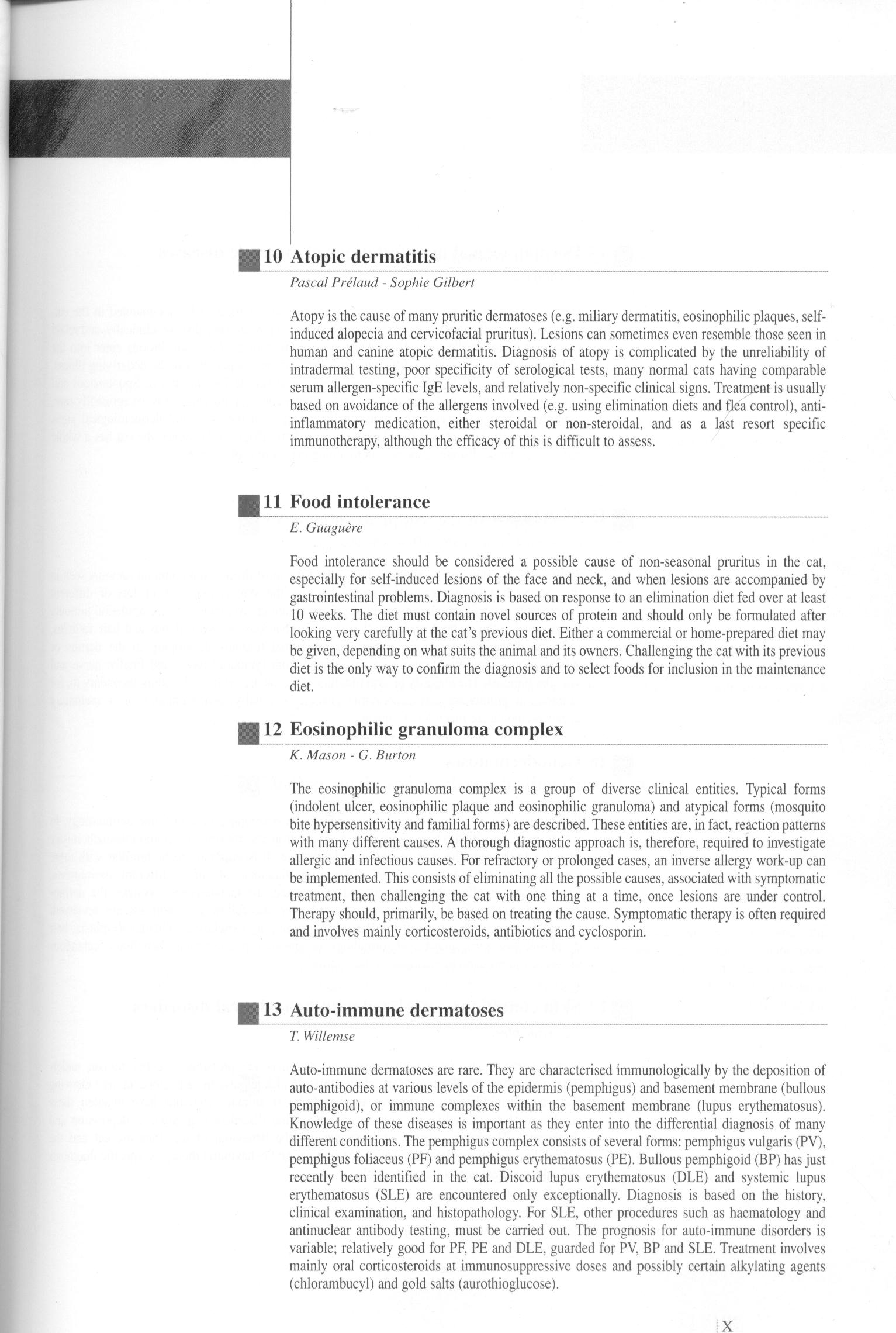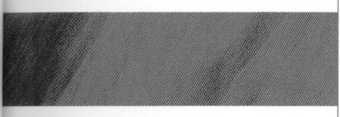4 (1321)


■ 10 Atopic dermatitis
Pascal Prelaud - Sophie Gilbert
Atopy is the cause of many pruritic dermatoses (e.g. miliary dermatitis, eosinophilic plaques, self-induced alopecia and cervicofacial pruritus). Lesions can sometimes even resemble those seen in human and canine atopic dermatitis. Diagnosis of atopy is complicated by the unreliability of intradermal testing, poor specificity of serological tests, many normal cats having comparable serum allergen-specific IgE levels, and relatively non-specific clinical signs. Treatment is usually based on avoidance of the allergens involved (e.g. using elimination diets and flea control), anti-inflammatory medication, either steroidal or non-steroidal, and as a last resort specific immunotherapy, although the efficacy of this is difficult to assess.
gil Food intolerance
E. Guaguere
Food intolerance should be considered a possible cause of non-seasonal pruritus in the cat, especially for self-induced lesions of the face and neck, and when lesions are accompanied by gastrointestinal problems. Diagnosis is based on response to an elimination diet fed over at least 10 weeks. The diet must contain novel sources of protein and should only be formulated after looking very carefully at the cat’s previous diet. Either a commercial or home-prepared diet may be given, depending on what suits the animal and its owners. Challenging the cat with its previous diet is the only way to confirm the diagnosis and to select foods for inclusion in the maintenance diet.
gl2 Eosinophilic granuloma complex
K. Mason - G. Burton
The eosinophilic granuloma complex is a group of diverse clinical entities. Typical forms (indolent ulcer, eosinophilic plaque and eosinophilic granuloma) and atypical forms (mosquito bite hypersensitivity and familial forms) are described. These entities are, in fact, reaction pattems with many different causes. A thorough diagnostic approach is, therefore, required to investigate allergic and infectious causes. For refractory or prolonged cases, an inverse allergy work-up can be implemented. This consists of eliminating all the possible causes, associated with symptomatic treatment, then challenging the cat with one thing at a time, once lesions are under control. Therapy should, primarily, be based on treating the cause. Symptomatic therapy is often required and involves mainly corticosteroids, antibiotics and cyclosporin.
13 Auto-inimune dermatoses
T. Willemse
Auto-immune dermatoses are rare. They are characterised immunologically by the deposition of auto-antibodies at various levels of the epidermis (pemphigus) and basement membranę (bullous pemphigoid), or immune complexes within the basement membranę (lupus erythematosus). Knowledge of these diseases is important as they enter into the differential diagnosis of many different conditions. The pemphigus complex consists of several forms: pemphigus vulgaris (PV), pemphigus foliaceus (PF) and pemphigus erythematosus (PE). Bullous pemphigoid (BP) has just recently been identified in the cat. Discoid lupus erythematosus (DLE) and systemie lupus erythematosus (SLE) are encountered only exceptionally. Diagnosis is based on the history, clinical examination, and histopathology. For SLE, other procedures such as haematology and antinuclear antibody testing, must be carried out. The prognosis for auto-immune disorders is variable; relatively good for PF, PE and DLE, guarded for PV, BP and SLE. Treatment involves mainly orał corticosteroids at immunosuppressive doses and possibly certain alkylating agents (chlorambucyl) and gold salts (aurothioglucose).
X
Wyszukiwarka
Podobne podstrony:
Kapanadze eng + H GB1 In my opinion this is the Principle of Tesla T2 - Iron core
10 7 Have your negotiation aces’ up your sleeve’ for the time of impasse, when they will be the most
2011 6- 10 stycznia, LSA, 7 styczeń, NAAHoLS (North American Association for the History of the
64 (132) 6: Bacterial dermatoses Figurę 6:2: Secondarypyoderma in a cat with atopic dermatitis Figur
2010-10-06 $ strukturalne PASCAL C. O** obiektowe DELPHI VB JAVA^^~Ewolucja języków
44 (130) tlił UlttgUUMyWiUW rubu *»£ AM«»W» I r.?V
53 (177) Atopic Dermatitis do zobiektywizowanej oceny klinicznej ciężkości zmian skórnych w Systńn t
fuel tank fuel type Fuel Tank Fuel tank capacity is 10.5 f (2.8 US gal) in-cluding 2.5 f (0.66 US ga
« « I Fig. 10 Repetitive work whcn throwtng the pieces into boxes. This task is probably one cause o
S20C 409120813302 a; i? ie 14 12 10 a c A 2 19 1/ 15 13 11 9 t 5 3 1 Fetting Pledsc efer to the
skanowanie0042 (10) the preparation of lesson plans can be very helpful. Especially, if this knowled
11 Plant metaphors for the expression of emotions (10) Her pretty face reveals a m
74 RIKEN Accel. Próg. Rep. 24 (1990)111*3-10. A Multitracer Study of the Adsorption of Metal Element
więcej podobnych podstron